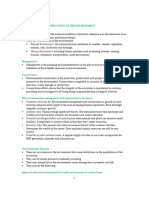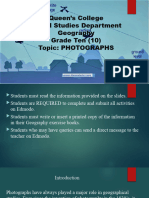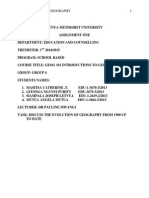0 ratings0% found this document useful (0 votes) 2K views14 pagesMap and Mapwork Form 1
Notes on maps and mapwork
Copyright
© © All Rights Reserved
We take content rights seriously. If you suspect this is your content,
claim it here.
Available Formats
Download as PDF or read online on Scribd
CHAPTER 9
Questions on
Maps and Map Work
1. What is a map? (2 marks)
2. la) What is a plan? (2 marks)
{b) Sketch a plan of a classroom. (2 marks}
3. What ia picture? (2 marks)
4. Give three types of maps. (3 marks)
5. What are sketetemaps? (8 mari}
6, Draw a sketch map of your school. (4 marks)
7. Give the characteristics of a good sketch map. {4 marks}
8 (a) Define Atlas maps. (2 macks)
(Y Slate the characteristics of Atlas maps. (4 marks)
9. {a} What are Topographical maps. 2{ marks)
{b] State another name for Topographical maps. (1 mark)
[o) State the characteristics of Topographical maps.
(@ marks}
10, State the uses of the following:
(i) Sketch maps. (2 marks)
(ii) Atlas maps. (8 marks}
Gi) Topographical maps. (4 marks)�11. (a) Expiein What marginal information on a map is.
(3 marks}
(b) Explain five examples of marginal information on a map.
(10 marks}
12. Define a scale on a map. (2 marks}
13. Give and describe the types of scales. (6 marks}
14. Demonstrate conversion of scales below,
(a) A statement into a representative fraction. Eg. Lom
represents %akm. — {2 marks)
(b) From RF to statement. (2 marks}
(6) From linear scale to RF (2 marks}
(6) RF into linear scale, (2 marks)
15. List three sizes of scales found on maps. {3 marks}
16, Give two ways of using scales on maps. (2marks)
17. How does one estimate distance on maps? (2 marks}
18. Explain how the following can be used to accurately
measure distance on a map.
(a) A pair of dividers, (2 marks)
{b) Using a straight edge of paper (paper edge). (2 marks)
19. Explain how the following ean be used to accurately
measure length of an irregular line on a map
(@) Using pair of dividers. (3 marks)
(b) Using’a piece of string or thread. (3 marks)
(6) Using a piece of paper. (3 marks)
20. How does one calculate area of rectangle and a triangle on
maps? (2 marks}
ow to Bass Geography O&A 87�21, Explain how the folioing can be used to calculate the "
area of irregular shapesfon a map.
(a) Composite method. (3 matks)
{b] Graph paper sped (3 marks}
(6) The grid squar} method. (3 marks}
22. (a) Give the sheet tile “er map 1 on page 125. (i marks)
(0) What type of map is this? (1 marks)
{c) What is the scale of the map? (1 marks)
(6) Convert this scale to a statement scale. (2 marks)
23. (a} What is the vertical interval of the contours in map 1
ton page 125? (1 marks}
(©) Measure the length of the dry weather road from 83051
to the end of the Kepteren and Eldoret road. (2 marks}
(c) What is the arca of the forest {including Bamboo forest)
at the north western corner of the area covered by t
map? (3 marks}
24. (a) Give the map name for map 1 page 125. (1 marks)
(b) What cash crop is cultivated in plantations in the
map? 1
{c) What factors have influenced settlement in the area
covered by the map? (6 marks)
{@) With evidence from the map describe the climate of the
area covered by the map. (8 marks)
25, Using the Kericho map (tap 2 page 128) provided, answer
the following questions,
(a) Describe the economic activities found in the area
covered by the map. (6 marks}
(b) What are the roles of Kericho town /municipality?
(8 marks}
{c} Give two types of settlements patterns found on the
map. (2 marks)
88 Howto Puss Geography O&A�CHAPTER 10
- Answers on
Maps and Map Work
1. Amap is a representation of a part or the whole of the
carth’s surface on a flat surface, or horizontal plane, such
‘ag a sheet of paper or a board,
2. (a) Plan:
+ This i a map of a stall place. It is drawn to scale.
+ Aplan usually has a large scale c.g 1:10000
(b) Plan of a classroom.
HUHGE
HAAG E
3. Apicture iz an image of a real object.
~ Apicture can be: - a drawing,
~ a painting,
~a photograph.
«It is not to scale.
4. Three main types of maps
1. Sketch maps,
2. Atlas maps.
3. Topographical maps.
} Mocet A 89�Sketch map
‘This «a roughly drawn map which gives a general
uth of the area represented.
thes show specific information which the user needs to
know .
they sre not to scale.
© Sketch map of a sehool.
vaiectexisties of a good sketch map.
‘Should be neat and clear.
Nrould have a title,
Snould have @ key ~ Explains what different
ibols stand for,
vould have a compass point.
snap:
'ss a collection of maps bound together i.e into
book,
visties of Atlas maps.
ey have a small scale e.g 1:280000 tole
‘h map has a lot of information,
a ta Bas Geography 06 A \�Atlas maps may show.
+ Relief,
~ Climate
- Vegetation,
~ Political Divisions i.e countries, provinces and
districts,
~ Population maps. - Show population and settlement
~ Economic maps - Show various human activities,
9. a] Topographical maps:
This is a map that shows physical features in a given
area,
(bj Retief maps
(c) Characteristics of Topographical maps.
- They show such features as valleys, hills, rivers,
mountains, lakes, ponds, swamps and vegetation,
- They also show human features such as ponds, farms,
towns and factories,
10. The uses of:
(i) Sketch maps:
~ To summarize information. A lot of information ean
be shown on such a map
~ To show locations of various items.
(i) Atlas maps
~ They can be used to locate other countries and
compare their sizes and shape.
- Show climates of different places.
~ Show distribution of geographical phenomena eg.
vegetation, land use, voleanoes, rivers, valleys etc.
(ii) Topographical maps.
~ Travelers use them to find direction.
~ Calculate distance between focations
~ Show the shortest route for travelers.
- Locate physical features.
Geogr 1�11. (a) Marginal information:
~ This is additional information given on the fringe or
margin of a map.
- It helps give more information about the map itself.
(0) Examples of marginal information on a map,
(i) Map name - This is the name of the map e.g. Kericho
(ii) Map identification ~ it includes
- Map series - a numer identifying map
(7780/D0S108).
~ Sheet number or sheet index e.g. 118/1
+ This identifies ft
~ Edition; Year when map copy was produced e.g 1976.
{ii} Sheet tide e.g, Bast Africa 1: 50, 000 (Kenya)
{i») Grid systems numbers. The grid Bastings and
Northings are shown at the edge of the map.
(v) Latitudes and longitudes: These are also shown on the
edges of the map, West and East, North and South.
(vi) Compass direction: ‘This shows the various Norths and
their relationships. ie
~ True North
- Grid North,
~ Magnetic North,
+ It also gives the magnetic variation: the variation of
magnetic North from Grid North and from the true
north,
Grid North
True Norti
Magnetic
North
0°30"
Mogreic Decimation oF at Sue 1980
92 How tostass Geography OG A�18. Reconnaissance.
+ This is also known as a pre ~ visit It is familiarization tour of the
area to be studied,
19, Benefits of reconnaissance.
1) Helps oue to decide on identify methods of data colletion
1) Helps identify the equipment be used
6) To familsasize oneself with the arce ond seve time during the actus
study.
4 Helps to determine the shortest or best rout tothe study area
©) Helps assess the suitability ofthe acea ag a study are as source of
information,
4) One can use ito yet the guides they wil need,
Helps idenify problems ene may encounter utd therefore avoid
ber
1 feenables ono to access the cosis ofthe Mud and prepare
adequately.
i) Iehelps in formating relevant objectives and hypothesis,
5) Whelps one to draw up 2 workable work sched
20. Benefits of class discussions before field work
4) Helps to identify the type of data to be collected
') Helps decide on the suitability ofthe set objectives and hypothesis,
6) Helps adjust objectives and hypothesis wheze necessary.
4) Helps decide methods of deta recording
24. Questionnaire
~ This isa list of questions to be used to collect information during
fiekdwonk tis a too fr collecting Fieldwork information.
22, Types of questionnaires
a) Open ended Questionnaire
b) Rigid or closed questionnaire
23.2) open-ended questionnaire.
- This isa list of questions which acts as a guide-o the interviewer,
+ Answers given to the questions may prompt other questions which
‘were not in the original ist ef questions,
Its also called a personal interview questionnaire.
iow t9se Geography 0 & A . lot�\
+b) Rigid or closed questionnaire
~ This isa Hist of questions usually with possible answers administered
to the respondent
- ye eepndent tks the possible answers. E.g, how old are you?
(0-140) (by 15-2984 (c) 30-40] (ay as— 590
24. Qualities of a good questionnaire
8) Questions should be simple, short and clear.
») Questions should be arranged in a iogical sequence’ systematically
©) Questions sould be relevant to field study.
6) Questions should be sensitive to respondents feelings.
©) Questions should be objective and unbiased
25. Benefits of dividing into groups before going for the actual
fieldwork.
2) Reduce congestion or overcrowding during the study.
) Creates order when cerrying out tel study,
©) Bnables students cover the whole area of sty.
A) Itenables students to pick a wide variety of data
5) Saves on time
1) Reduces fatigue’ tiredness among the students! pariipans.
8) Right formation of yrouns resis in efficiency
26. Documents which may be prepared before the actual fieldwork.
a) Maps of the area ~ shows routes 10 follow, obstacles ete
1b) Sketch maps ~ To fl information infield
©) Tables ~ To fill information in field,
) Questionnaire ~ List of questions to be asked in the fic.
27. Benefits of reading through relevant hooks.
+ Helps identify data tobe colloete.
+ Help identify the techniques one mey need to eolect the information.
28. Work schedule.
- Its a timetable of field work activities: what isto he dose and when.
29. Purposes of a work schedule
4) Avoid wasting time — Proper time management.
1) To ensure all important areas are covered
6) To avoid deviating from the original plan - To keep tothe purpose
of the fieldwork.
9) Itshows the time required to carry out the field work.
108, Hay to ftss Geography O&A�(if) Large scale maps: These represent a small area on a
piece of paper. They have alot of details. E.g. 1:2500,
110000, 1:25000,
16, Uses of scales:
~ They may be used to;
-Measure distance on maps
~ Calculate areas on maps,
17. This can be done by using your eye to get the distance
‘and estimating it on the linear scale.
18. (a) A pair of dividers.
~ Open the pair of dividers between 2 points
+ Measure the distance on the linear seale,
- Read off the distance.
~ For distances longer than the divider can measure,
divide it into parts, measure the parts on the near
seale and add up the distance
(b) Using a straight edge of paper.
> Join the two points between which distance is ta be
measured using a straight ruler
~ Use a paper with a straight edge and put it against the
line.
~ Mark the distance on the straight edged paper.
~ Put the paper on the linear scale and measure the
distance.
19. How the following can be used to accurately measure
distance of an irregular line on a map
(a) Using a pair of divides
Divide the lengths into straight sections,
+ number the sections,
~ Measure the sections using the divider.
~ Read the distances on the linear scale.
~ add all the lengths to get total distance.�(0) Using a piece of string or thread
+ Get a non ~ elastic thread and mark one end with ink,
+ Put the marized point at the beginning of the distance to
bbe measured.
~ Run the thread along the distance to be measured up to
the end.
- Mark the end with ink.
~ Measure the distance on the linear scale.
Road Morked
Place the thread along Thread
the road to be measured
10000 2 3
|c)_ Using a piece of paper.
~ Get a paper with a straight edge and mark a starting
point on one end.
~ Put the marked starting point at the
distance to be measured. 1
~ Rotate the paper, marking straight parts on the paper.
Measure all short straight distances.
SN
ning of
Folded piece of paper
measures straight
sections
96 ss Geo�+ Measure the total distance on the paper on the linear
scale,
Using the t
linear scale | starting
to get the point
distance,
from the
folded paper
~The part less than Ikm should be measured from zero to
the left in 100's of metres
20. Use mathematical formulas e.g. Length x breadth for
rectangle,
% base * height for triangle,
| > Remember to convert map distance into ground distance
\ (kilometers)
‘21, (a) Composite method,
~ Draw regular shapes on the irregular shapes
- Calculate the area of the regular shape.
~ Add the areas of regular shapes to get the area of
irregular shapes.
Using
squares and
‘triangles to
get the area
of an
irregular
)— Tregiler hope iy shape
ow to ass Geography Q&A 97�(b) Graph paper method.
~ Trace the irregular shape on tracing paper.
+ Place the tracing paper on graph paper haying Lem.
‘squares
+ Count full squares and get area in km?,
+ Count 4 squares; divide by 2(in kim?)
~ Add total No, of km? to get area.
eg. aren in kin?
Full squares 10 (1*1cm) 5
% squares 15 (1*1em) 3.75.
Total area Sea
(b) The grid square method
= Agrid square on a topographical map is 2cm x 2em. .
~ Using the linear scale we can see this is Tkm x Lkm.
= So each one grid square is km?
To find area of an irregular shape on such a map, follow
the following steps.
Area in kin?
Full squares e.g +28.0. bem
Y squares e.g. 13~ 8/2 =
Add total area in km?
22. (a) East Albica 1:50000 Kenya,
(b) It is a topographical mp ~ contours show altitude and
the landforms e.g. escarpment along easting 85/88.
(6) 1: 50000,
(a) Lem = 50000er.
Jem » 50000 = 500 m
100)
lem="skin
Jem represents km.
23, {a} 2Ometres ~ given in the key as v.i ~ 20.
fe) 11Stm! Lien,
) ‘rea (lem?)
Full squares 3 3
‘squares 6 3
Total area km’.
98 ow ins Geography O&A�an
{ 24. (a) Kipkabus
[b) Wattle trees ~ This is indicated by letter W on the
plantations,
~ {c} - Relief ~ Settlements found in the gentle sloping areas.
‘No settlement in steep areas to the North East of the
area covered by map.
- Vegetation ~ No Settlements in forests to the North.
West of the area covered by map.
- Transport - Settlements found along the road (linear
settlements).
{d) - The region is likely to be cool and wet.
- Moderate to high rainfall 1000 mm and above as
shown by presence of forests especially bamboo.
Also many rivera.
- Cool temperatures ~ This is indicated by high altitude
‘over 2000 m and presence of forests.
- Low relative humidity ~ high altitude shows
low/moderate temperatures and so the evaporation
rates are low.
25. (a) - Farming ~ Presence of labour lines, tea estates.
- Transport ~ Presence of roads.
= Trade ~ Presence of Keriche town.
) - It is an administrative centre ~ Presence of District
Commissioner's office,
- It is an educational centre ~ presence of colleges and.
schools.
~ It ig a recreational centre — presence of race track and
clubs.
- [tis a health centre ~ Presence of hospitals,
(c] - Nucleated settlement ~ in Kericho municipality,
~ Dispersed settlements ~ rural settlement.
99



























































